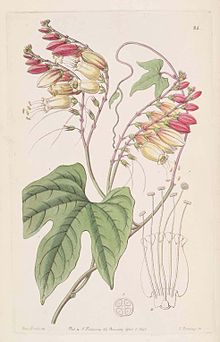Stellar winds
| Stellar winds | ||||||||||||
|---|---|---|---|---|---|---|---|---|---|---|---|---|

Stellar winds |
||||||||||||
| Systematics | ||||||||||||
|
||||||||||||
| Scientific name | ||||||||||||
| Ipomoea lobata | ||||||||||||
| ( Cerv. ) Thell. |
The rating winch or Spanish flag ( Ipomoea lobata ) is a plant type from the genus of Morningglory ( Ipomoea ) adapted to family of wind plants counts (Convolvulaceae). It originates from southwest Mexico and maybe also from Central America .
description
Appearance and leaf
The star bindweed is a perennial herbaceous plant and grows as a creeper . The stems are smooth or grooved, at most slightly hairy at the nodes and reach a length of 3 to 6 m.
The alternate leaves arranged on the stem axis are divided into a petiole and a leaf blade. The petiole is no more than 10 centimeters long. The membranous leaf blade is egg-shaped with a length and width between 3 and 12 cm in outline, three-lobed with a blunt or pointed upper end. The leaf margins are usually smooth or rarely toothed on the lower leaf lobes.
Inflorescence and flower
In the home regions, the flowering period is between September and November. The flowers are on one side, in forked, up to 40 cm long inflorescences ( wraps ).
The hermaphroditic flowers are radial symmetry and five-fold with a double flower envelope . The five pointed sepals of the same shape are 1.5 cm long with blunt upper ends. The five petals are fused tubular-sack-like, somewhat inflated, curved and 1.8 to 2 cm long. The color of the crown changes as it blooms: while the bud is colored red, the flower color changes to orange just before opening. The open flower is yellowish, later often almost white. The plant owes its name “Spanish flag” to this change in color. The five stamens are more than twice as long as the crown, from which they protrude far. The stamens are white and the anthers are yellow. The white stylus towers over the stamens.
Fruit and seeds
The bald capsule fruit has a diameter of 6 to 7 mm and contains one to four seeds. The brown to black seeds are spherical with a diameter of 4 to 5 millimeters.
ecology
The striking color change of the flowers is unusual.
Occurrence
Ipomoea lobata is widespread in southern Mexico in the states of Michoacán, San Luis Potosí and Guerrero and in Guatemala ; there is also information that the natural range extends to South America. It thrives in deciduous forests and oak forests at altitudes between 0 and 1300 meters. The species is a neophyte in some tropical countries in America, Africa and Asia.
Systematics
The first description under the name ( Basionym ) Mina lobata was made in 1824 by Vicente Cervantes in Pablo de La Llave and Juan José Martinez de Lexarza : Novorum Vegetabilium Descriptiones , 1, pp. 3–4 based on cultivated specimens whose source material was collected in Mexico. The new combination to Ipomoea lobata (Cerv.) Thell. was published in 1919 by Albert Thellung in the quarterly publication of the Natural Research Society in Zurich , Volume 64, p. 775. Other synonyms for Ipomoea lobata (Cerv.) Thell. are Convolvulus mina (G.Don) Kuntze , Ipomoea mina (G.Don) Voss , Ipomoea versicolor Meisn. , Mina cordata Micheli , Quamoclit lobata (Cerv.) House , Quamoclit mina G.Don , Quamoclit pallescens Brongn. ex Neumann . The specific epithet lobata refers to the lobed leaves.
Ipomoea lobata belongs to the section Mina from the subgenus Quamoclit in the genus Ipomoea .
use
As an ornamental plant it is widespread in the tropics and subtropics around the world and is also cultivated in temperate latitudes as an - usually annual - ornamental plant.
literature
- Andreas Bärtels: Color Atlas Tropical Plants , E. Ulmer, Stuttgart, 1989, ISBN 3-8001-3448-9 , p. 155
- Data sheet of the University of Halle.
- Flora Mesoamericana . (Spanish, sections occurrence and description)
- Convolvulaceae - Ipomoea lobata (Cerv.) Thell. - Cresta de gallo near Malezas de México . (Spanish, sections description and occurrence)
Individual evidence
- ^ A b Rafaël Govaerts (ed.): Ipomoea - World Checklist of Selected Plant Families of the Royal Botanic Gardens, Kew. Last accessed on November 26, 2017.
- ^ A b c Ipomoea lobata in the Germplasm Resources Information Network (GRIN), USDA , ARS , National Genetic Resources Program. National Germplasm Resources Laboratory, Beltsville, Maryland. Retrieved September 10, 2013.
- ↑ New combination scanned at biodiversitylibrary.org .
- ^ Ipomoea lobata at Tropicos.org. Missouri Botanical Garden, St. Louis, accessed September 10, 2013.

